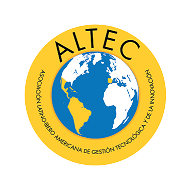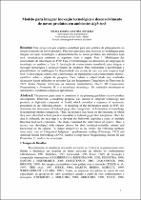| dc.contributor.author | Martins Oliveira, Selma Regina | |
| dc.date.accessioned | 2021-05-27T15:55:46Z | |
| dc.date.available | 2021-05-27T15:55:46Z | |
| dc.date.issued | 2013 | |
| dc.identifier.uri | https://hdl.handle.net/20.500.13048/751 | |
| dc.description.abstract | : Este artigo tem por objetivo contribuir para uma política de planejamento no desenvolvimento de novos produtos. Para isto apresenta uma proposta de modelagem para integrar inovação tecnológica e desenvolvimento de novos produtos em ambientes high tech, sistematizada conforme as seguintes fases e etapas: Fase 1: Modelagem das necessidades de informação no PDP; Fase 2: Determinação das dimensões de integração da tecnologia ao produto; e Fase 3: Avaliação do conhecimento transferido para integrar a inovação tecnológica e desenvolvimento de produtos. Para demonstrar a factibilidade e plausibilidade da modelagem foi desenvolvido um estudo de caso em uma empresa high tech. A investigação contou com a intervenção de especialistas com conhecimento técnico- científico sobre o objeto de pesquisa. Para reduzir a subjetividade nos resultados alcançados foram utilizados os métodos Lei dos Julgamentos Categóricos de Thurstone de 1927, Redes Neurais Artificiais; os métodos multicriteriais Electre III, Compromise Programinng e Promethee II; e a tecnologia Neurofuzzy. Os resultados mostraram-se satisfatórios, validando a proposta apresentada. | |
| dc.description.abstract | : The present paper aims to contribute to the planning guidelines in new product
development. Therefore, a modeling proposal was created to integrate technology and
products in high-tech companies in Brazil, which considers a sequence of systematic
procedures in the following phases: 1) modeling of the information needs in PDP, (ii)
determine the dimensions of technology-product integration; 3) Evaluation of knowledge
in technology-product integration. Thus, the research was based on the literature, in which
they were identified as best practices (models) in technology-product integration. Once the
data is collected, the next step is to develop the fieldwork; applying a study of multiple
Brazilian high-tech companies. The study comprised the intervention of experts. Thus, a
survey was developed with experts chosen for their technical-scientific criteria and
knowledge on the subject. To reduce subjectivity in the results, the following methods
were used: Law of Categorical Judgment - psychometric scaling (Thurstone, 1927) and
Artificial Neural Networking (ANN), method Compromise Programming, Electre III and
Promethee II - multi-criteria analysis. | |
| dc.language.iso | por | |
| dc.rights | info:eu-repo/semantics/openAccess | |
| dc.rights | Atribución-NoComercial-SinDerivadas 2.5 Perú | |
| dc.rights.uri | http://creativecommons.org/licenses/by-nc-nd/2.5/pe/ | |
| dc.subject | Innovación tecnológica | |
| dc.subject | Nuevos productos | |
| dc.subject | Entornos de alta tecnología | |
| dc.title | Modelo para integrar inovação tecnológica e desenvolvimento de novos produtos em ambientes high tech | |
| dc.type | info:eu-repo/semantics/conferenceObject | |
| dc.relation.conferencedate | 27-31 de octubre, 2013 | |
| dc.relation.conferencename | XV Congreso Latino-Iberoamericano de Gestión Tecnológica | |
| dc.relation.conferenceplace | Porto, Portugal | |
| dc.contributor.corporatename | Universidade de São Paulo | |


